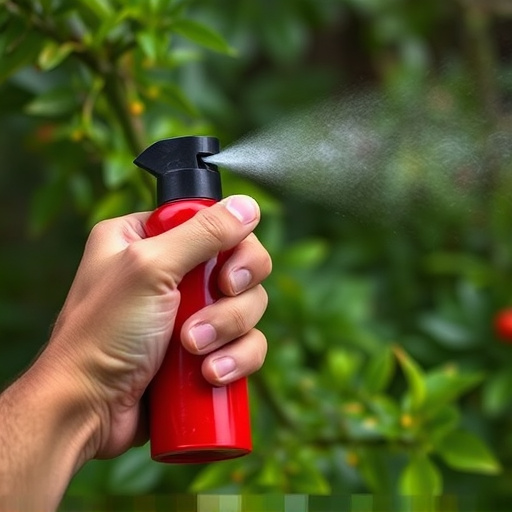TL;DR: Neutralizing pepper spray on the face involves swiftly removing contaminated clothing, flushing the affected area with water for at least 15 minutes, and seeking medical attention if irritation persists. Capsaicin, the active ingredient in pepper spray, binds to pain receptors causing burning sensations, tears, and temporary blindness. Safety precautions include wearing protective gear, storing pepper spray properly, understanding legal implications, and using it as a last resort. Regularly inspect for damage and familiarize yourself with de-escalation techniques.
Personal safety is paramount, especially in uncertain times. One powerful tool to consider is inflammatory pepper spray, designed to deter and neutralize potential threats instantly. This article breaks down the science behind pepper spray, its effectiveness in neutralizing threats on the face, and offers essential tips for safe handling and storage. We also explore legal considerations and best practices for responsible use, ensuring you’re prepared while respecting the law.
- Understanding Pepper Spray: What It Is and How It Works
- The Science Behind Neutralizing Pepper Spray on the Face
- Essential Tips for Safe Handling and Storage of Pepper Spray
- Legal Considerations and Best Practices for Using Pepper Spray Legally
Understanding Pepper Spray: What It Is and How It Works
Pepper spray, also known as oleoresin capsicum (OC) spray, is a non-lethal self-defense tool designed to incapacitate an assailant temporarily. It’s a liquid substance that contains capsaicin, the same chemical responsible for the heat sensation in chili peppers. When sprayed into someone’s eyes and face, pepper spray irritates the mucous membranes, causing intense pain, tearing, and temporary blindness. This disorienting effect gives users an opportunity to escape or defend themselves further.
To neutralize pepper spray on the face, it’s crucial to act quickly. Remove any clothing or materials that have come into contact with the spray and flush the affected area with plenty of water for at least 15 minutes. Seek medical attention if irritation persists or if breathing becomes difficult. Understanding how pepper spray works is the first step in knowing how to react and recover from its effects effectively.
The Science Behind Neutralizing Pepper Spray on the Face
The effectiveness of pepper spray lies in its ability to neutralize aggressors by disrupting their vision, breathing, and movement. When pepper spray comes into contact with the eyes and face, it triggers a chemical reaction. The active ingredient, capsaicin, binds to pain receptors, causing an intense burning sensation. This irritates the eyes, leading to tears and temporary blindness, while the nose and throat experience severe irritation, making breathing difficult.
The science behind its neutralizing effect on the face is a complex interaction of chemicals. Capsaicin stimulates nerve endings, releasing neurotransmitters that signal pain and inflammation. The reaction is designed to be a powerful deterrent, allowing users time to escape potentially harmful situations. Understanding this science ensures individuals are equipped with a reliable personal safety tool when facing dangerous encounters.
Essential Tips for Safe Handling and Storage of Pepper Spray
When handling pepper spray, safety is paramount. Always wear protective gloves and eye gear to avoid direct contact with the spray, as it can cause severe irritation or even chemical burns. In case the spray comes into contact with your skin or face, immediately flush the affected area with plenty of water for at least 15 minutes. This will help to neutralize the pepper spray and alleviate symptoms.
For optimal storage, keep your pepper spray in a cool, dry place away from direct sunlight or extreme temperatures. Ensure it is out of reach of children and pets. Store it in its original packaging with the safety clip intact to prevent accidental discharge. Regularly inspect the spray for any signs of damage or leakage, and replace it promptly if needed.
Legal Considerations and Best Practices for Using Pepper Spray Legally
When considering the use of pepper spray for personal safety, it’s crucial to understand the legal implications and best practices that govern its application. The legality of carrying and using pepper spray varies significantly across jurisdictions, with some regions allowing its possession for self-defense while others have strict regulations or outright bans. Before purchasing or employing this tool, research local laws to ensure compliance. Many areas require permits or registration, specific storage conditions, and even mandatory training for use.
Best practices dictate that pepper spray should only be deployed as a last resort when facing an imminent threat. Aiming for the face is generally recommended as it neutralizes the assailant quickly, but users must exercise caution to avoid unintended targets. Proper ventilation is essential during usage due to the spray’s potential impact on respiratory systems. Users should also be familiar with de-escalation techniques and seek alternatives whenever possible, such as noise makers or personal alarms, before resorting to pepper spray.
Personal safety is paramount, and understanding how to effectively use and handle pepper spray can be a valuable skill. By knowing the science behind its neutralizing properties, you can ensure your safety in potentially dangerous situations. Remember, proper usage depends on legal considerations, making it crucial to familiarize yourself with local regulations. With the right knowledge and precautions, you’ll be equipped to defend yourself confidently while prioritizing safe handling practices.
